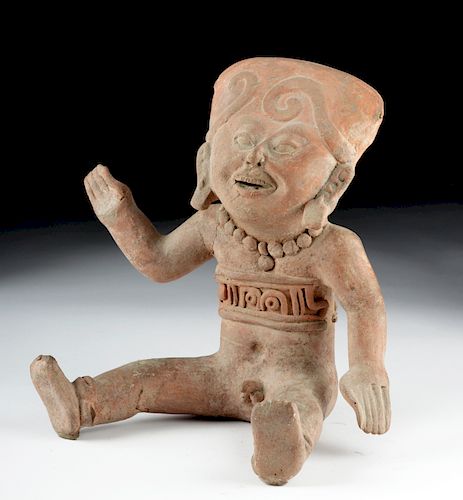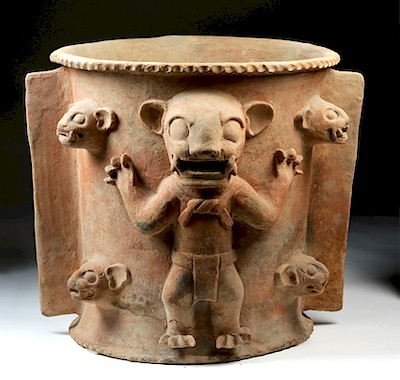Adorable Veracruz Pottery Seated Sonriente
Lot 120
About Seller
Artemis Fine Arts
686 S Taylor Ave, Ste 106
Louisville, CO 80027
United States
Selling antiquities, ancient and ethnographic art online since 1993, Artemis Gallery specializes in Classical Antiquities (Egyptian, Greek, Roman, Near Eastern), Asian, Pre-Columbian, African / Tribal / Oceanographic art. Our extensive inventory includes pottery, stone, metal, wood, glass and textil...Read more
Estimate:
$1,500 - $2,500
Absentee vs Live bid
Two ways to bid:
- Leave a max absentee bid and the platform will bid on your behalf up to your maximum bid during the live auction.
- Bid live during the auction and your bids will be submitted real-time to the auctioneer.
Bid Increments
| Price | Bid Increment |
|---|---|
| $0 | $25 |
| $300 | $50 |
| $1,000 | $100 |
| $2,000 | $250 |
| $5,000 | $500 |
| $10,000 | $1,000 |
| $20,000 | $2,500 |
| $50,000 | $5,000 |
| $100,000 | $10,000 |
| $200,000 | $20,000 |
About Auction
By Artemis Fine Arts
Dec 6, 2018
Set Reminder
2018-12-06 10:00:00
2018-12-06 10:00:00
America/New_York
Bidsquare
Bidsquare : DAY 2 : Pre-Columbian, Ethnographic & Fine Art
https://www.bidsquare.com/auctions/artemis-gallery/day-2-pre-columbian-ethnographic-fine-art-3699
Day 2 of an important 2-dy auction featuring ancient and ethnographic art from around the world. Today's sale will feature Pre-Columbian, Native American, African / Tribal, Ethnographic, Spanish Colonial, Fine Art, much more. Artemis Fine Arts info@artemisgallery.com
Day 2 of an important 2-dy auction featuring ancient and ethnographic art from around the world. Today's sale will feature Pre-Columbian, Native American, African / Tribal, Ethnographic, Spanish Colonial, Fine Art, much more. Artemis Fine Arts info@artemisgallery.com
- Lot Description
Pre-Columbian, Mexico, Veracruz, ca. 100 BCE to 800 CE. A charming pottery "Sonriente" male figure, shown seated, from the Veracruz region of Gulf Coast Mexico. Like many hollow pieces of pottery from this region, he functions as an ocarina, with a mouthpiece at one elbow and a series of holes on his back to be played. Sonrientes, or "smiling faces", are the most famous pottery from this period in Veracruz (known as Remojadas for its keystone archaeological site). Like this one, they depict wide, smiling, childlike faces, often with teeth showing. This figure also wears traditional jewelry, including what appear to be delicately carved cowrie shell anklets around his ankles; this is interesting because cowrie shells are a Pacific coast product and so would have had to be traded to arrive in the Veracruz region. Atop his head is an elaborate headdress, and around his body is a belt with glyph-like geometric symbols. Size: 10.95" W x 10" H (27.8 cm x 25.4 cm)
Smiling faces are very rare in Mesoamerican art, but in Remojadas and the surrounding area, there are thousands of these Sonrientes figures, leading to a mystery for archaeologists. Some have suggested that the smiles are the result of consuming the alcoholic beverage pulque, or taking hallucinogenic drugs; others see them as representing performers.
Provenance: private southern California, USA collection, acquired in the 1970s to mid-1980s
All items legal to buy/sell under U.S. Statute covering cultural patrimony Code 2600, CHAPTER 14, and are guaranteed to be as described or your money back.
A Certificate of Authenticity will accompany all winning bids.
We ship worldwide and handle all shipping in-house for your convenience.
#140925One arm is repaired in two places and one leg is also repaired in one place.Condition
- Shipping Info
-
All shipping is handled in-house for your convenience. Your invoice from Artemis Gallery will include shipping calculation instructions. If in doubt, please inquire BEFORE bidding for estimated shipping costs for individual items.
-
- Buyer's Premium



 EUR
EUR CAD
CAD AUD
AUD GBP
GBP MXN
MXN HKD
HKD CNY
CNY MYR
MYR SEK
SEK SGD
SGD CHF
CHF THB
THB
















